Microscopic Distribution and Development Strategy of Residual Oil in Tight Sandstone
Abstract
:1. Introduction
2. Oilfield Overview
3. Microscopic Pore Structure
4. Microscopically Visualized Water Flooding Experiment
5. Experimental Results and Analysis
5.1. Microscopic Residual Oil Types
- A.
- Membrane residual oil (Figure 5a): This refers to the crude oil adsorbed on the pore wall surface. When the adsorption force of the pore surface is greater than the viscous force of water, it is a type of residual oil that is attached to the rock surface in the form of a film. This type of remaining oil is positively correlated with the water flooding degree of the reservoir and occurs in a large amount in the lipophilic pores, which are channels connecting two independent oil bodies.
- B.
- Droplet residual oil (Figure 5b): During the water flooding process, the crude oil separates from the pore wall to form free oil droplets, which are carried and transported by water. However, due to the large size of oil droplets, when it passes the radius of a throat which is smaller than that of oil droplets, the high oil–water interfacial tension and the capillary resistance prevent the oil droplets to deform. Therefore, the residual oil is formed by stagnation at the mouth of the throat.
- C.
- Columnar residual oil (Figure 5c): For low-permeability and ultra-low-permeability reservoirs, the pore–throat ratio is large and the difference in the distribution of pores and throats is relatively large. In small throats, the resistance formed by capillary force is relatively large (Cao Rongliang, 2019) [29]. The speed of the displacement fluid entering the large pores is much greater than that entering the small throats. When the displacement fluid breaks through the large pores, it will return to quickly surround the small throat, thereby forming a residual oil trap at the small throat. Consequently, a part of the oil in the small pore can be extracted or not be extracted. In this way, a columnar residual oil is formed.
- D.
- Blind-end residual oil (Figure 5d): In the process of water flooding, fluids tend to migrate in the direction of low potential energy; therefore, the pores in the water sweeping surface are interconnected, that is, there is an inlet and an outlet, but there is only one inlet in the blind end pore. If the injected water does not reach and causes the oil to stay in these pores, a blind-end-like residual oil will be formed. The formation of this kind of residual oil mainly depends on the shape of the pores.
- E.
- Clustered residual oil (Figure 5e): This kind of residual oil is ubiquitous. It often occurs in patches, but it will decrease in the late stage of water flooding. The difference in the radius of the pore and throat of the ultra-low-permeability reservoir causes the finger-like sweeping of injection water, and the clustered residual oil is left behind (Zahid M. A. et al., 2020) [30]. The oil often exists in smaller pores and throats or in large pores surrounded by small throats. In addition, the start-up pressure gradient is relatively large during the water flooding process in low-permeability reservoirs; when the displacement pressure difference is smaller than the start-up pressure gradient, clusters of residual oil will also be formed.
5.2. Microscopic Residual Oil Distribution at Different Water Cutting Stages
6. Strategies to Improve Residual Oil Recovery
6.1. Change of the Direction of Displacement
6.2. Periodic Injection
7. Implementation and Application of Strategy
7.1. Residual Oil Characteristics in the Study Area
7.2. Analysis of Residual Oil in Coring Wells
7.3. Analysis of Development Effect in Well Site
8. Conclusions
- (1)
- The formation of internal pores and throats is affected by the depositional environment in the Fuyang oil reservoir. Primary intergranular pores and pore-reduced and necked throats are mainly developed. The ultra-low-permeability characteristics of the reservoir are remarkable, and the throat radius is positively correlated with permeability; therefore, the throat radius is small and concentrated. This type of pore throat is an important factor in the accumulation of local residual oil.
- (2)
- Research on the types and distribution of residual oil with the application of the laser confocal method and the microscopic visualization enabled through a photolithographically fabricated glass model shows that the micro-residual oil of the Fuyang reservoir can be divided into five types, which are clustered residual oil, columnar residual oil, droplet residual oil, membrane-like residual oil, and blind-end residual oil, according to the pore throat characteristics of low-permeability reservoirs. The study area is dominated by clustered residual oil, which accounts for 60% of the total. The clustered residual oil cannot be completely displaced with the continuous development of water injection and becomes more scattered columnar, oil droplet, membrane, and blind-end residual oil.
- (3)
- The blocking or permeability of the lateral accretion interlayer is the main factor affecting the distribution of residual oil inside the point bar of the meandering river of the Fuyang reservoir; the lower part of the point bar is eroded by the river during deposition to form an interconnected high-permeability reservoir, a high-permeability channel is formed during the water injection development process, resulting in flooding at the bottom of the point bar; the residual oil is distributed in the updip direction of a single lateral accretion body inside the point bar, forming a lithological updip and annihilation type residual oil.
- (4)
- Changing the displacement direction and periodic water injection can increase the displacement pressure difference and overcome the capillary resistance effect. Oil and water were alternated so that the residual oil in the cluster, column, oil drop, film, and blind-end shape could finally be driven. Changing the displacement direction was beneficial to the recovery of residual oil in the fine throat and avoided the dominant seepage of injected water in the big pore throat, and the recovery rate was increased by more than 2.14%. Periodic water injection is conducive to adjusting the displacement pressure difference, thereby reducing the constraining force of the throat on residual oil and increasing the recovery rate by more than 3.98%. By applying these two strategies to production, the average daily oil increased by 0.26 tons per well, and the oil displacement efficiency increased by 44.28%.
9. Suggestion
Author Contributions
Funding
Data Availability Statement
Conflicts of Interest
References
- Aydin, G.; Jang, H.; Topal, E. Energy consumption modeling using artificial neural networks: The case of world’s highest consumers. Energy Sources Part B Econ. Plan. Policy 2016, 11, 212–219. [Google Scholar] [CrossRef]
- Li, X.; Yang, Z.; Li, S.; Huang, W.; Zhan, J.; Lin, W. Reservoir characteristics and effective development technology in typical low-permeability to ultralow-permeability reservoirs of China National Petroleum Corporation. Energy Explor. Exploit. 2021, 39, 1713–1726. [Google Scholar] [CrossRef]
- Li, C.; Liu, X.; You, F.; Wang, P.; Feng, X.; Hu, Z. Pore Size Distribution Characterization by Joint Interpretation of MICP and NMR: A Case Study of Chang 7 Tight Sandstone in the Ordos Basin. Processes 2022, 10, 1941. [Google Scholar] [CrossRef]
- Liu, X.; Yan, L.; Gao, Q.; Liu, Y.; Huang, H.; Liu, S. Effect of Salinity on the Imbibition Recovery Process of Tight Sandstone Reservoirs. Processes 2022, 10, 228. [Google Scholar] [CrossRef]
- Zhong, X.; Zhu, Y.; Jiao, T.; Qi, Z.; Luo, J.; Xie, Y.; Liu, L. Microscopic pore throat structures and water flooding in heterogeneous low-permeability sandstone reservoirs: A case study of the Jurassic Yan’an Formation in the Huanjiang area, Ordos Basin, Northern China. J. Asian Earth Sci. 2021, 219, 104903. [Google Scholar] [CrossRef]
- Li, T.; Gao, H.; Wang, C.; Cheng, Z.; Xue, J.; Zhang, Z.; Luo, K.; Li, N.; Liu, X.; Cao, J. Oil utilization degree at various pore sizes via different displacement methods. J. Pet. Explor. Prod. Technol. 2022, 12, 2271–2287. [Google Scholar] [CrossRef]
- Georgiadis, A.; Berg, S.; Makurat, A.; Maitland, G.; Ott, H. Pore-scale micro-computed-tomography imaging: Nonwetting-phase cluster-size distribution during drainage and imbibition. Phys. Rev. E 2013, 88, 033002. [Google Scholar] [CrossRef] [Green Version]
- Li, P.; Zheng, M.; Bi, H.; Wu, S.; Wang, X. Pore throat structure and fractal characteristics of tight oil sandstone: A case study in the Ordos Basin, China. J. Pet. Sci. Eng. 2017, 149, 665–674. [Google Scholar] [CrossRef]
- An, S.; Yao, J.; Yang, Y.; Zhang, L.; Zhao, J.; Gao, Y. Influence of pore structure parameters on flow characteristics based on a digital rock and the pore network model. J. Nat. Gas Sci. Eng. 2016, 31, 156–163. [Google Scholar] [CrossRef]
- Lai, J.; Wang, G.; Wang, Z.; Chen, J.; Pang, X.; Wang, S.; Zhou, Z.; He, Z.; Qin, Z.; Fan, X. A review on pore structure characterization in tight sandstones. Earth-Sci. Rev. 2018, 177, 436–457. [Google Scholar] [CrossRef]
- Al-Khafaji, A.; Wilson, M.; Neville, A.; Wen, D. Pore-scale displacement efficiency during different salinity water flooding in hydrophilic and hydrophobic microstructures. Energy Fuels 2019, 33, 3859–3870. [Google Scholar] [CrossRef] [Green Version]
- Zhang, X.; Yuan, P. A Microscopic Experimental Device for Natural Gas Hydrate Photoetching Glass Model. CN107516462A, 26 December 2017. (In Chinese). [Google Scholar]
- Qiang, R.; Hu, W.; Guofa, L.; Weigang, Z.; Bingyu, G.; Junxiang, N. Effect of Microscopic Pore Throat Structure on Displacement Characteristics of Lacustrine Low Permeability Sandstone: A Case Study of Chang 6 Reservoir in Wuqi Oilfield, Ordos Basin. Geofluids 2022, 2022, 7438074. [Google Scholar] [CrossRef]
- Zhu, W.; Shen, M.; Dai, S.; Liu, K.; Qi, Y. Channel Evolution under the Control of Base-Level Cycle Change and the Influence on the Sustainable Development of the Remaining Oil—A Case in Jiang Ling Depression, Jiang Han Basin, China. Sustainability 2022, 14, 12518. [Google Scholar] [CrossRef]
- Yang, J.; Li, W.; Gao, S.; Zhang, J.; Zhang, Y.; Lu, J. Sedimentology, geological modeling and prediction of the remaining oil distribution in a complicated fault-block reservoir in the Weicheng Oilfield, Dongpu Depression, China. Geosci. J. 2019, 23, 791–804. [Google Scholar] [CrossRef]
- Zhang, M.; Fan, J.; Zhang, Y.; Liu, Y. Study on the relationship between the water cutting rate and the remaining oil saturation of the reservoir by using the index percolating saturation formula with variable coefficients. J. Pet. Explor. Prod. Technol. 2020, 10, 3649–3661. [Google Scholar] [CrossRef]
- Feng, C.; San, Q.; Shi, W.; Zhu, S. Reservoir heterogeneity and control of remaining oil distribution in the fourth member of Quanquan Formation in Fuyu Oilfield. J. China Univ. Pet. Ed. Nat. Sci. 2013, 37, 1–7. (In Chinese) [Google Scholar]
- Pengfei, X.; Yanshu, Y.; Weiqiang, L.; Feng, L.; Lei, Z. Distribution of remaining oil based on a single sand body analysis: A case study of Xingbei Oilfield. J. Pet. Explor. Prod. Technol. 2018, 8, 1159–1167. [Google Scholar] [CrossRef] [Green Version]
- Murugesu, T.S.; Masoudi, R.; Johare, D.B.; Jalan, S.; Marzuki, I.I. Integrated Approach in Determining Residual Oil Saturations to Water Sorw and its Impact on Potential Enhanced Oil Recovery EOR Volume Estimation. In Proceedings of the SPE/IATMI Asia Pacific Oil & Gas Conference and Exhibition, Jakarta, Indonesia, 17–19 October 2017. [Google Scholar]
- Wang, J.; Wu, S.; Li, Q.; Guo, Q. An investigation into pore structure fractal characteristics in tight oil reservoirs: A case study of the Triassic tight sandstone with ultra-low permeability in the Ordos Basin, China. Arab. J. Geosci. 2020, 13, 961. [Google Scholar] [CrossRef]
- Chauhan, A.; Salehi, F.; Jalalifar, S.; Clark, S.M. Two-phase modelling of the effects of pore-throat geometry on enhanced oil recovery. Appl. Nanosci. 2021, 13, 453–464. [Google Scholar] [CrossRef]
- Shi, J. Micro-pore structure and seepage characteristics of low-permeability reservoirs in Yushulin Oilfield. Sediment. Geol. Tethyan Geol. 2003, 23, 90–94. (In Chinese) [Google Scholar]
- Perrin, C.L.; Tardy, P.M.; Sorbie, K.S.; Crawshaw, J.C. Experimental and modeling study of Newtonian and non-Newtonian fluid flow in pore network micromodels. J. Colloid Interface Sci. 2006, 295, 542–550. [Google Scholar] [CrossRef] [PubMed]
- Pal, M. A microscale simulation methodology for subsurface heterogeneity quantification using petrographic image analysis with multiscale mixed finite element method. Pet. Sci. Technol. 2021, 39, 582–611. [Google Scholar] [CrossRef]
- Nelson, P.H. Pore-throat sizes in sandstones, tight sandstones, and shales. AAPG Bull. 2009, 93, 329–340. [Google Scholar] [CrossRef]
- Liang, X.; Zhou, F.; Liang, T.; Su, H.; Yuan, S.; Li, Y. Impacts of pore structure and wettability on distribution of residual fossil hydrogen energy after imbibition. Int. J. Hydrogen Energy 2020, 45, 14779–14789. [Google Scholar] [CrossRef]
- Zhang, D.; Gamage, R.P.; Perera, M.S.A.; Zhang, C.; Wanniarachchi, W.A.M. Influence of Water Saturation on the Mechanical Behaviour of Low-Permeability Reservoir Rocks. Energies 2017, 10, 236. [Google Scholar] [CrossRef] [Green Version]
- Bultreys, T.; Van Hoorebeke, L.; Cnudde, V. Multi-scale, micro-computed tomography-based pore network models to simulate drainage in heterogeneous rocks. Adv. Water Resour. 2015, 78, 36–49. [Google Scholar] [CrossRef]
- Cao, R. Oil-water mutual driving microscopic simulation research on low permeability reservoir. In IOP Conference Series: Earth and Environmental Science; IOP Publishing: Bristol, UK, 2019; Volume 300, p. 022081. [Google Scholar] [CrossRef]
- Zahid, M.A.; Chunmei, D.; Golab, A.N.; Lin, C.; Zhang, X.; Ge, X.; Songtao, W.; Munawar, M.J.; Ma, C.; Knuefing, L. Pore size distribution and reservoir characterization: Evaluation for the Eocene beach-bar sequence, Dongying Depression, China. Arab. J. Geosci. 2019, 12, 660. [Google Scholar] [CrossRef]
- Zhang, M.; Qi, M.; Lin, L. Comprehensive evaluation method of waterflooded layer in extra-low permeability reservoir of daqing peripheral oilfield. Lithol. Oil-Gas Reserv. 2016, 28, 93–101. (In Chinese) [Google Scholar]
- Rabbani, H.S.; Osman, Y.; Almaghrabi, I.; Rahman, M.A.; Seers, T. The control of apparent wettability on the efficiency of surfactant flooding in tight carbonate rocks. Processes 2019, 7, 684. [Google Scholar] [CrossRef] [Green Version]
- Moosavi, S.A.; Goshtasbi, K.; Kazemzadeh, E.; Bakhtiari, H.A.; Esfahani, M.R.; Vali, J. Relationship between porosity and permeability with stress using pore volume compressibility characteristic of reservoir rocks. Arab. J. Geosci. 2012, 7, 231–239. [Google Scholar] [CrossRef]
- Zhao, L.; Sun, X.; Liu, F.; Wang, P.; Chang, L. Study on Morphological Identification of Tight Oil Reservoir Residual Oil after Water Flooding in Secondary Oil Layers Based on Convolution Neural Network. Energies 2022, 15, 5367. [Google Scholar] [CrossRef]
- Andersen, P.Ø.; Standnes, D.C.; Skjæveland, S.M. Waterflooding Oil-Saturated Core Samples—Analytical Solutions for Steady-State Capillary End Effects and Correction of Residual Saturation. J. Pet. Sci. Eng. 2017, 157, 364–379. [Google Scholar] [CrossRef]
- Zhao, J.; Xu, H.; Chen, G.; He, C.; Yue, D.; Wu, S.; Wen, L. Research on meandering river reservoir deposition architecture and 3D modeling of the Gudao Oil field in the Bohai Bay Basin. J. Pet. Explor. Prod. Technol. 2017, 8, 73–83. [Google Scholar] [CrossRef] [Green Version]
- Liu, X.; Kang, Y.; Li, J.; Chen, Z.; Ji, A.; Xu, H. Percolation Characteristics and Fluid Movability Analysis in Tight Sandstone Oil Reservoirs. ACS Omega 2020, 5, 14316–14323. [Google Scholar] [CrossRef]
- Omran, M.; Akarri, S.; Torsaeter, O. The Effect of Wettability and Flow Rate on Oil Displacement Using Polymer-Coated Silica Nanoparticles: A Microfluidic Study. Processes 2020, 8, 991. [Google Scholar] [CrossRef]
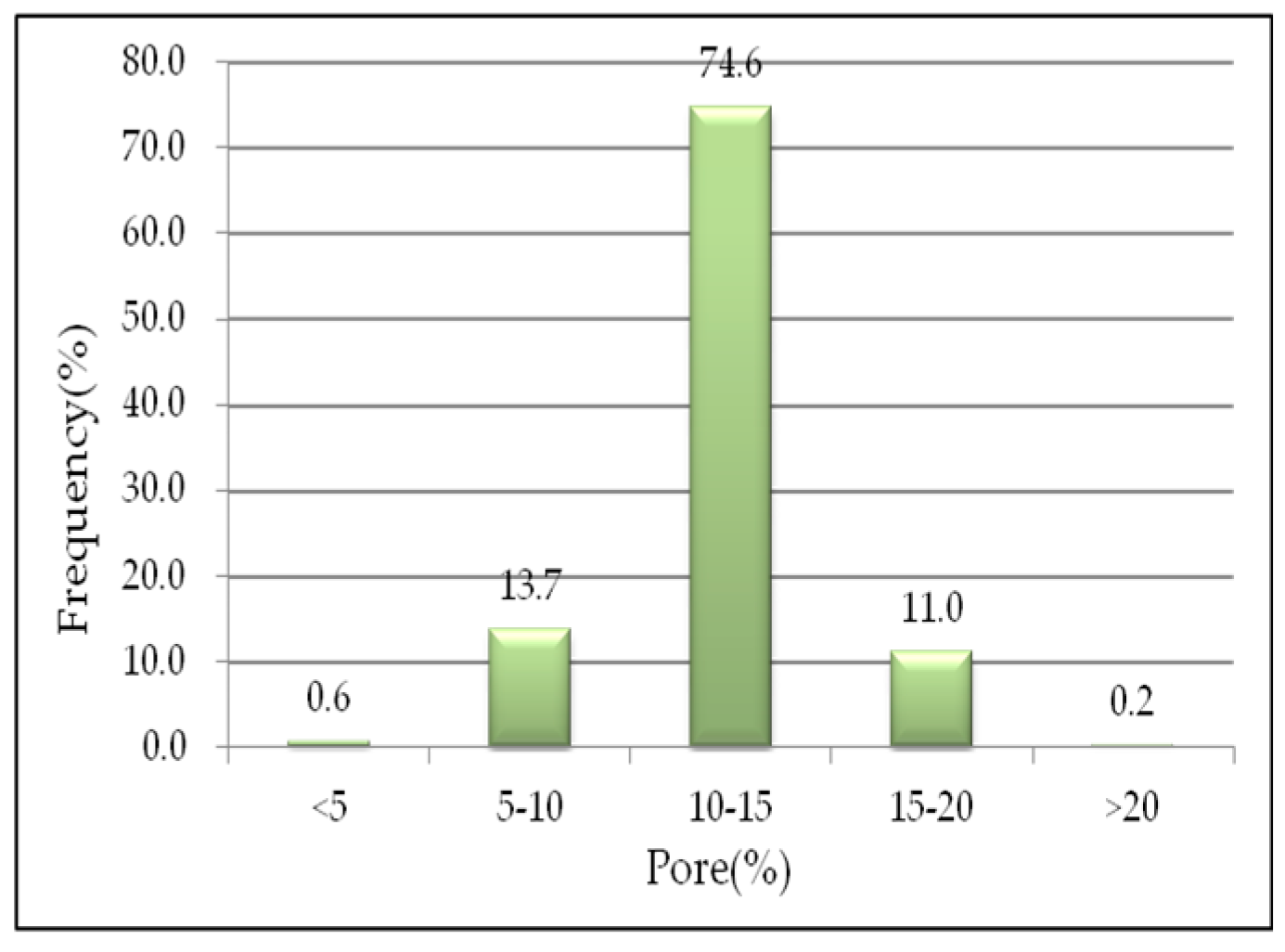
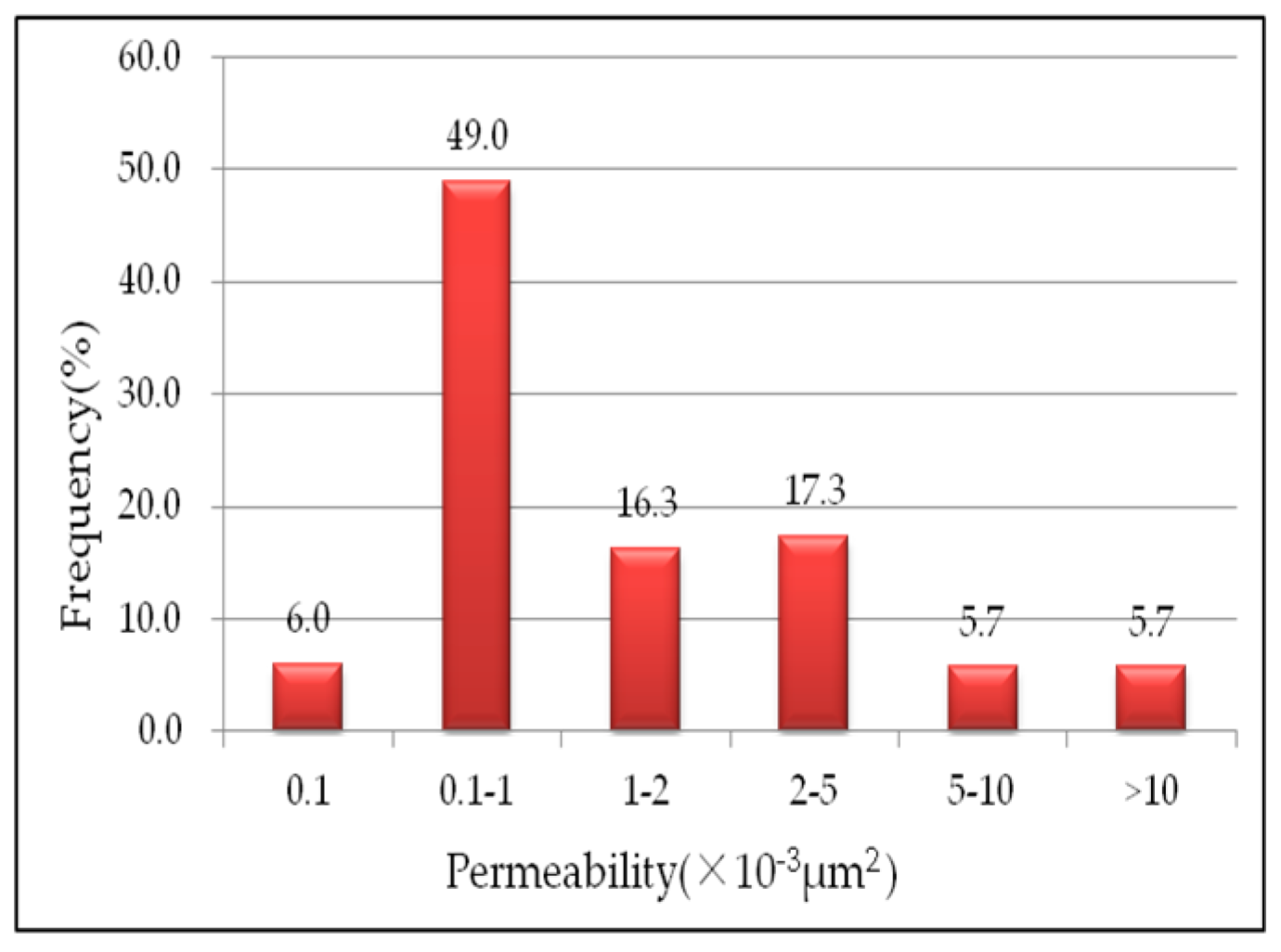
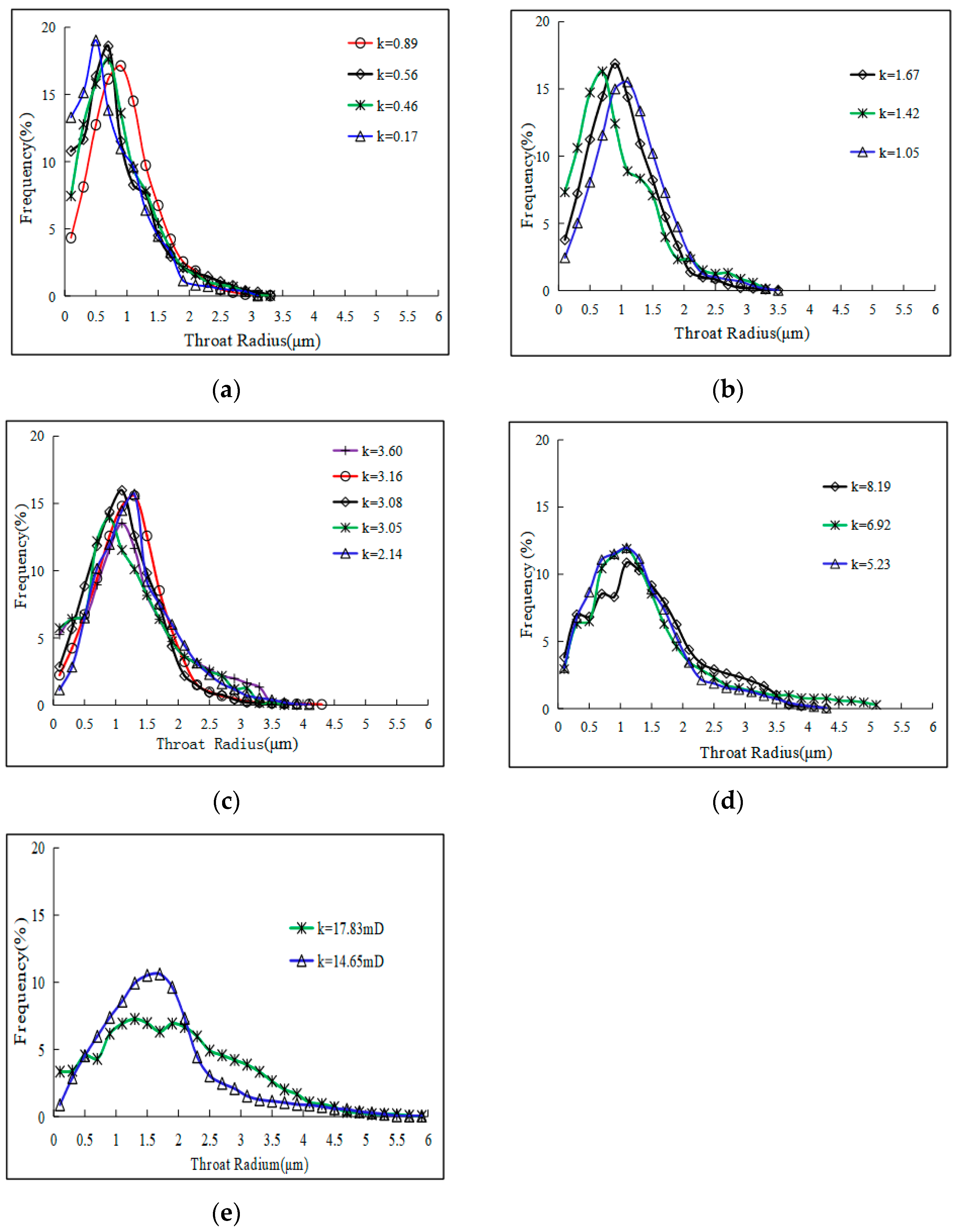
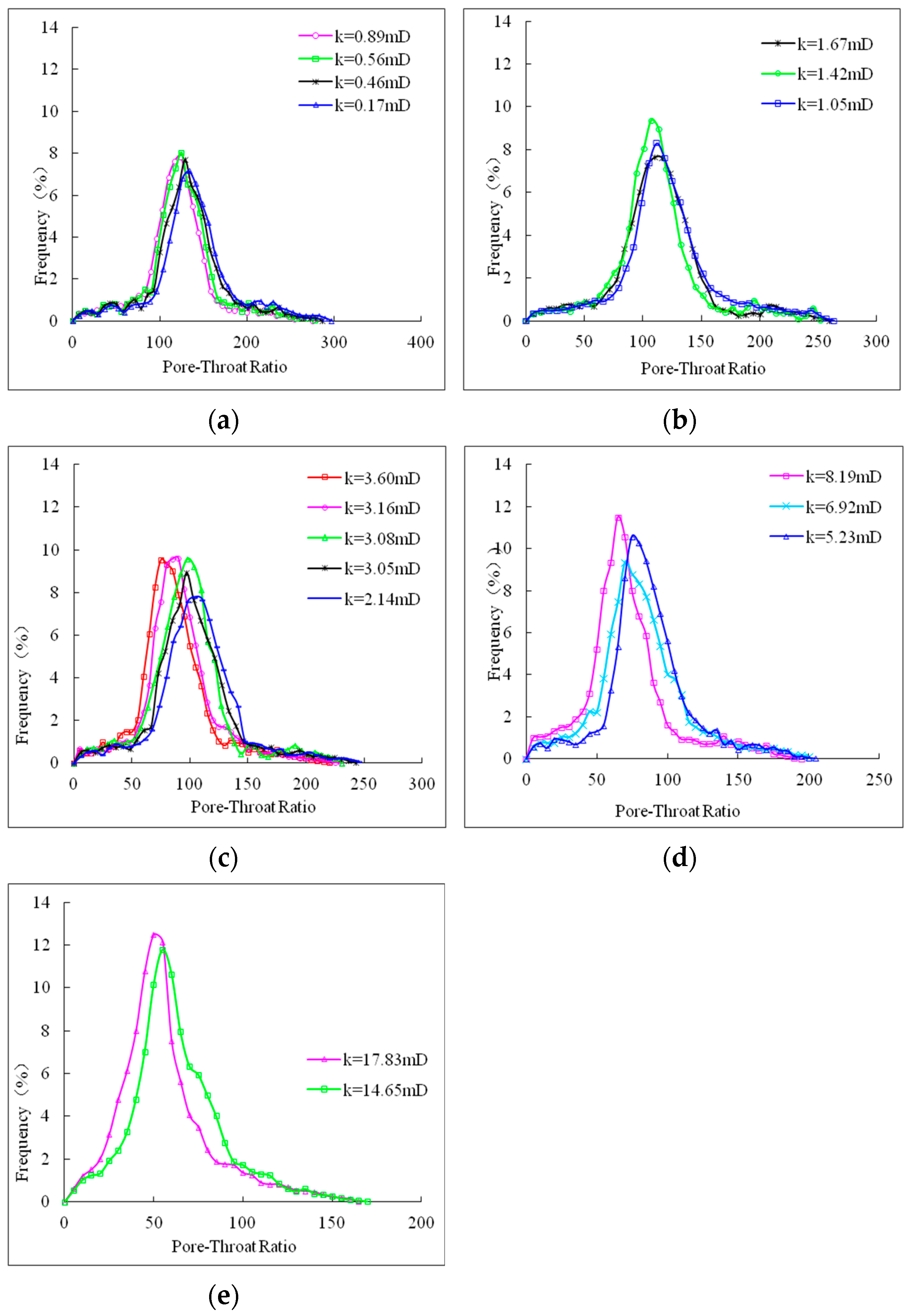
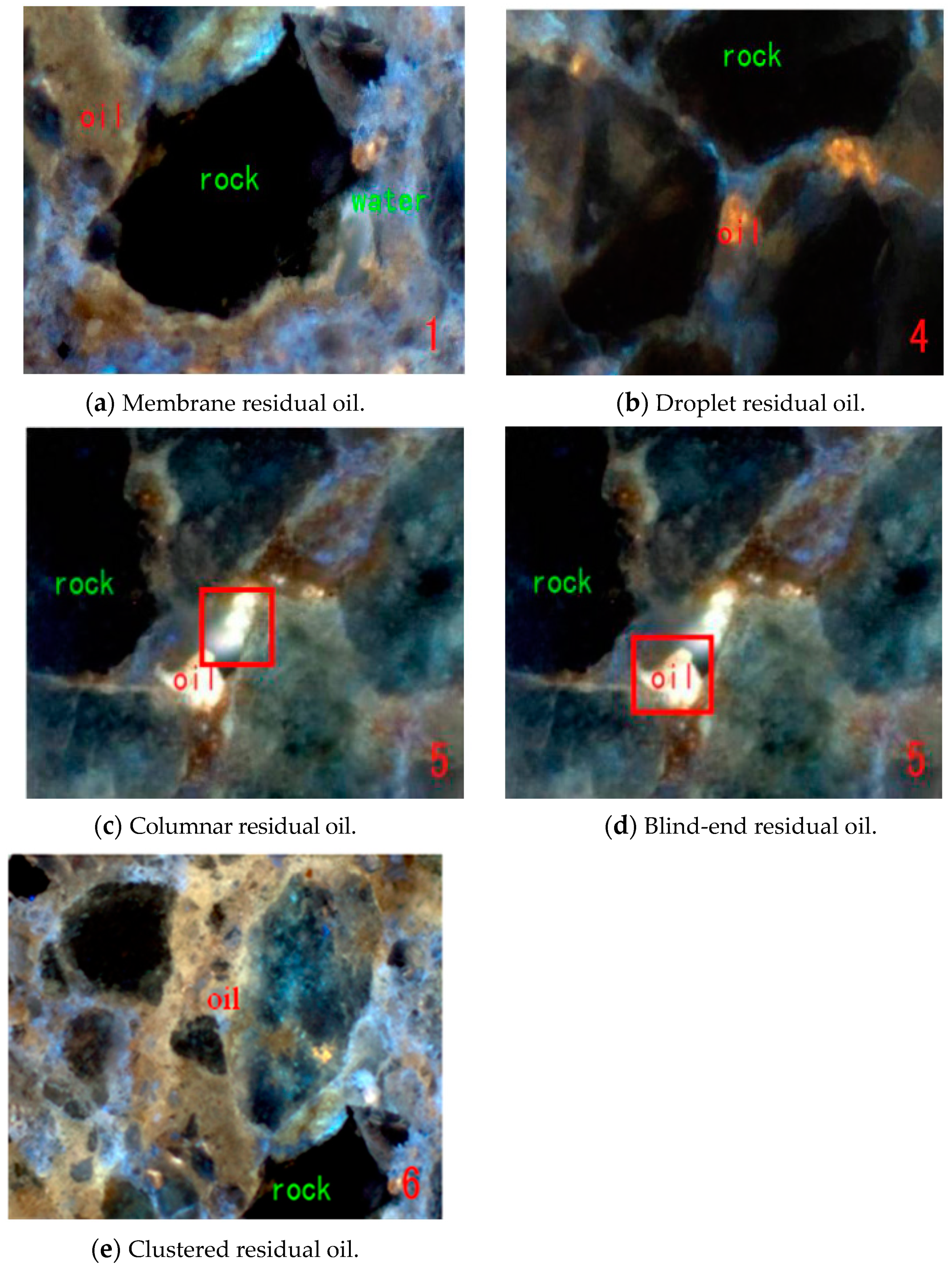
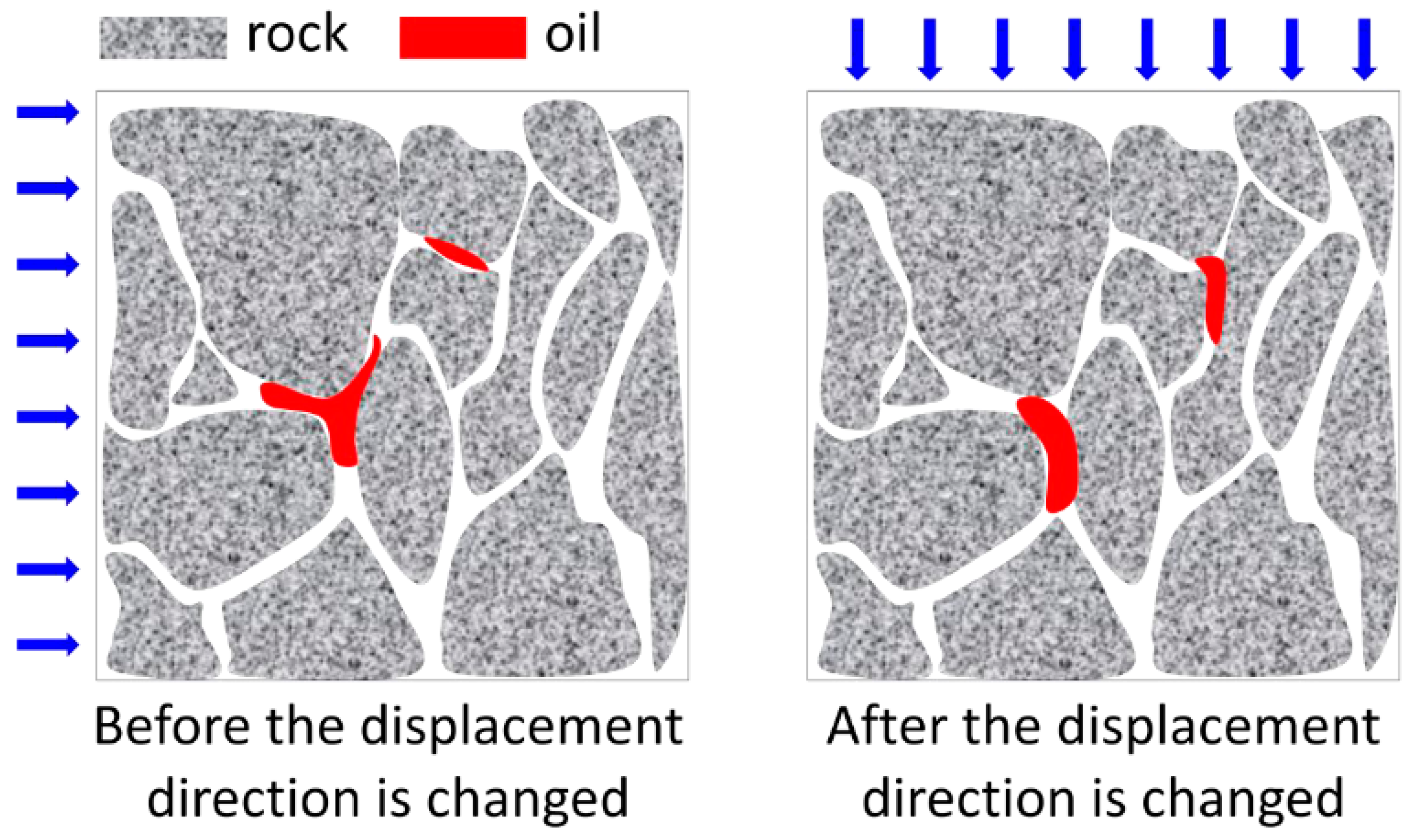
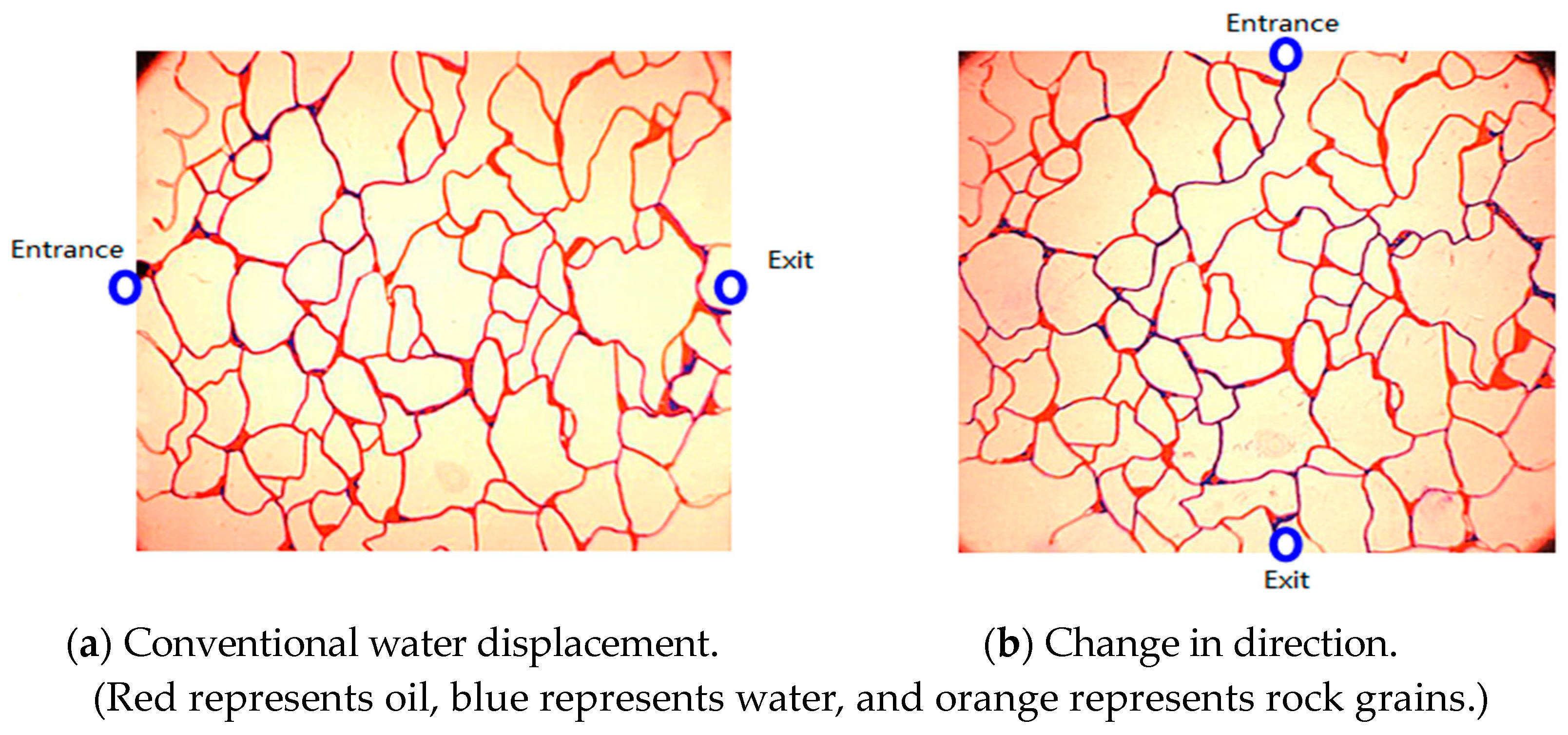

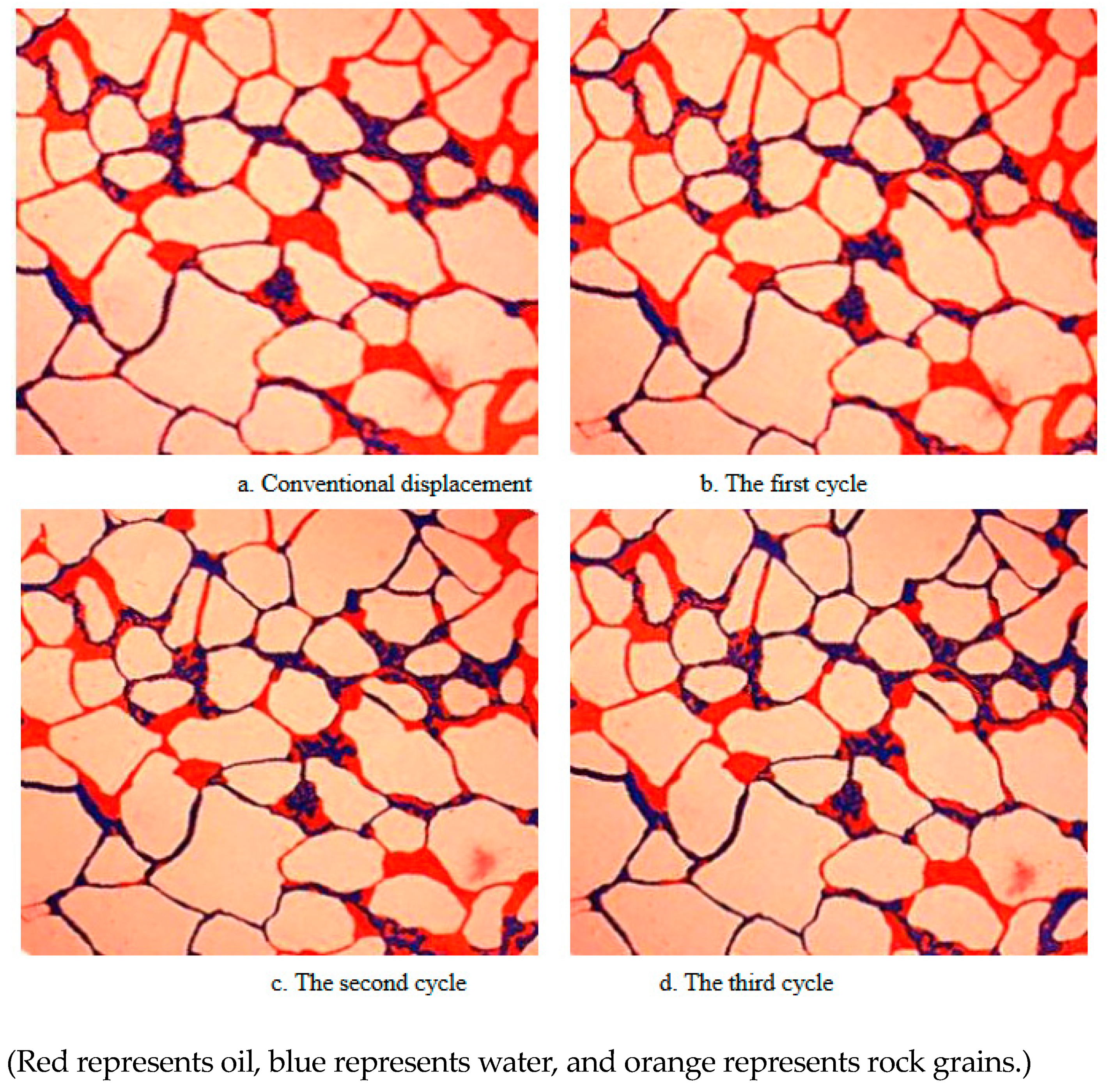
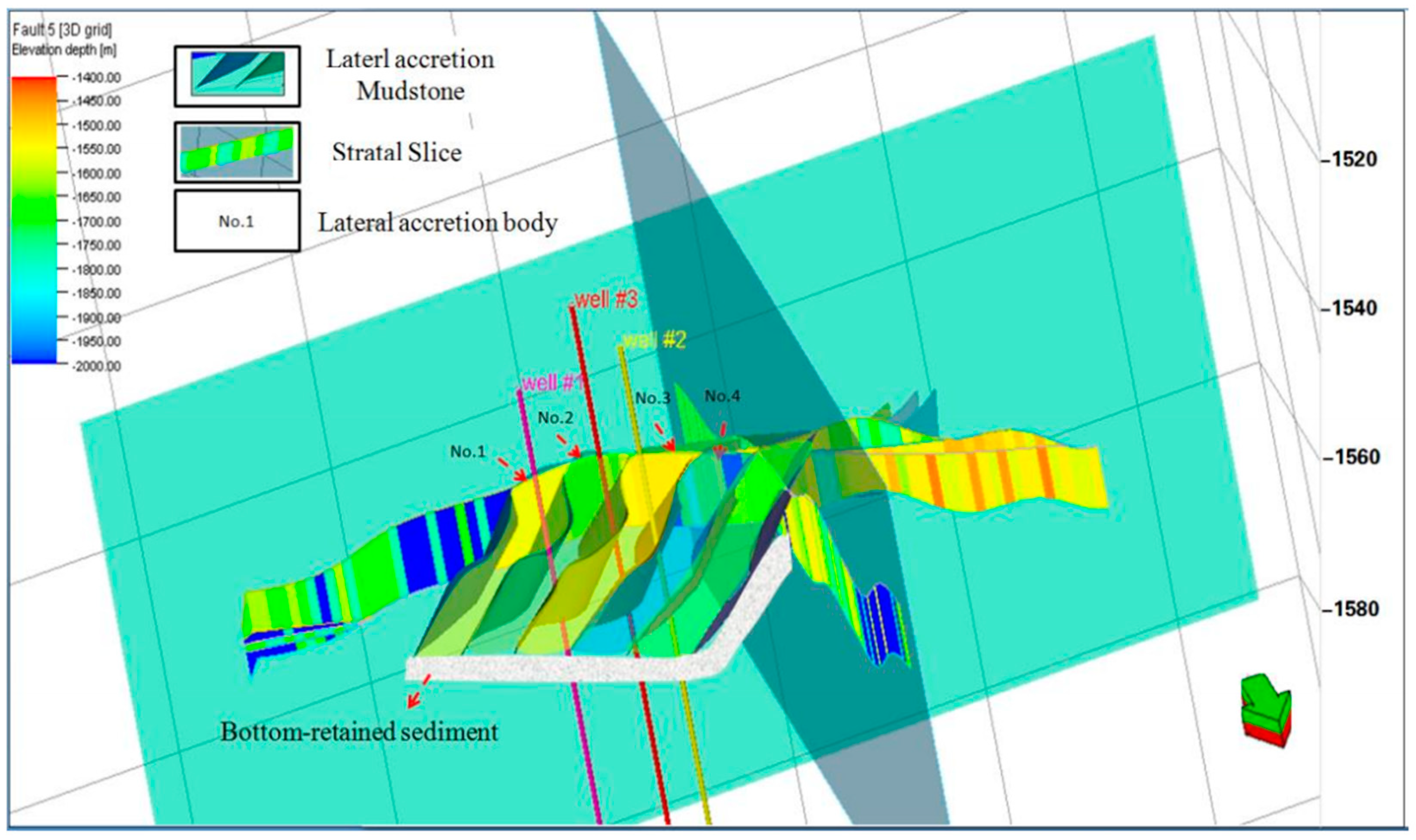

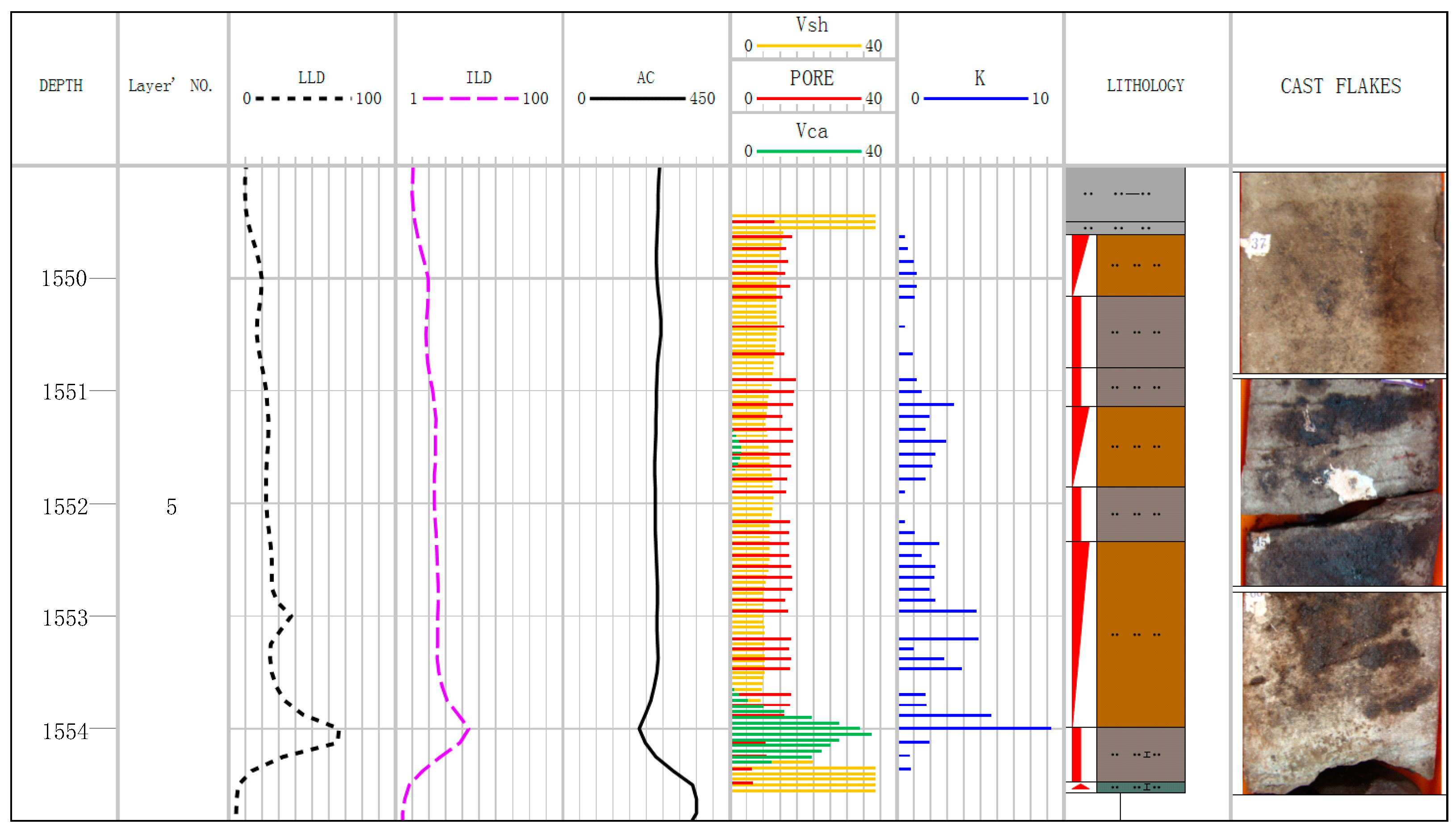
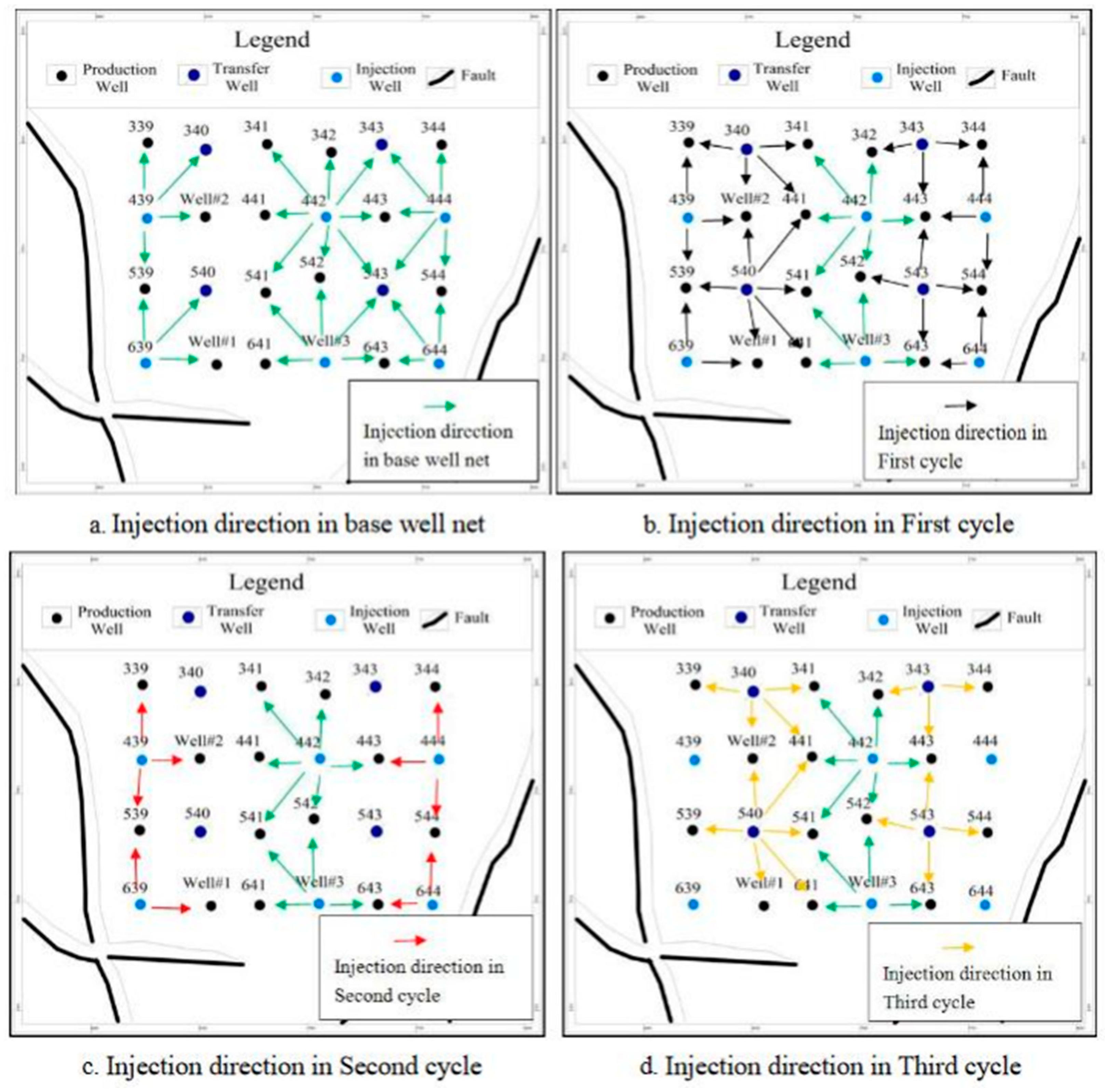
| Permeability Level (mD) | Water Cutting Stage | Saturation (%) of Residual Oil Type | Oil Saturation | Oil Displacement Efficiency (%) | ||||
|---|---|---|---|---|---|---|---|---|
| Clustered | Columnar | Droplet | Membrane | Blind-End | ||||
| <1 | Low | 36.68 | 4.75 | 4.61 | 3.97 | 4.14 | 54.15 | 8.83 |
| Medium | 24.22 | 7.97 | 9.79 | 4.24 | 4.08 | 50.30 | 14.74 | |
| High | 20.90 | 8.38 | 8.57 | 4.37 | 4.53 | 46.75 | 21.23 | |
| 1~2 | Low | 37.03 | 5.38 | 5.43 | 3.35 | 2.91 | 54.10 | 12.04 |
| Medium | 25.11 | 7.46 | 9.41 | 3.47 | 4.06 | 49.51 | 19.75 | |
| High | 22.27 | 7.73 | 7.93 | 3.95 | 4.18 | 46.06 | 24.76 | |
| 2~5 | Low | 39.2 | 4.13 | 2.55 | 2.95 | 2.11 | 50.94 | 14.38 |
| Medium | 27.97 | 7.15 | 7.31 | 2.08 | 3.32 | 47.83 | 22.12 | |
| High | 22.39 | 7.47 | 7.54 | 2.19 | 3.52 | 43.11 | 29.83 | |
| 5~10 | Low | 40.08 | 2.62 | 3.4 | 1.28 | 3.31 | 50.69 | 23.96 |
| Medium | 28.82 | 4.09 | 6.35 | 1.37 | 3.67 | 44.30 | 33.42 | |
| High | 23.18 | 4.31 | 6.57 | 1.39 | 3.86 | 39.31 | 40.33 | |
| >10 | Low | 41.28 | 3.13 | 1.14 | 1.9 | 1.43 | 48.88 | 28.75 |
| Medium | 29.34 | 4.19 | 4.72 | 1.7 | 1.87 | 41.82 | 39.45 | |
| High | 24.39 | 4.69 | 3.53 | 0.8 | 1.57 | 34.97 | 47.25 | |
| Permeability (mD) | Displacement Type | Saturation (%) of Residual Oil Type | Oil Saturation | Oil Displacement Efficiency (%) | ||||
|---|---|---|---|---|---|---|---|---|
| Clustered | Columnar | Droplet | Membrane | Blind-End | ||||
| 3.05 | Conventional | 17.55 | 6.47 | 8.13 | 3.00 | 4.46 | 39.61 | 36.12 |
| perpendicular | 16.26 | 5.72 | 8.15 | 3.01 | 4.48 | 37.62 | 39.33 | |
| Change (%) | −1.29 | −0.75 | +0.02 | +0.01 | +0.02 | −1.99 | +3.21 | |
| 8.19 | Conventional | 19.10 | 5.27 | 6.65 | 2.38 | 3.43 | 36.82 | 43.35 |
| perpendicular | 17.98 | 4.55 | 6.68 | 2.41 | 3.47 | 35.09 | 46.02 | |
| Change (%) | −1.12 | −0.72 | +0.03 | +0.03 | +0.04 | −1.74 | +2.67 | |
| 14.65 | Conventional | 20.81 | 4.43 | 4.95 | 1.92 | 3.07 | 35.18 | 48.26 |
| perpendicular | 19.93 | 3.67 | 4.99 | 1.98 | 3.15 | 33.72 | 50.40 | |
| Change (%) | −0.88 | −0.76 | +0.04 | +0.06 | +0.08 | −1.46 | +2.14 | |
| Permeability (mD) | Displacement Type | Saturation (%) of Residual Oil Type | Oil Saturation | Oil Displacement Efficiency (%) | ||||
|---|---|---|---|---|---|---|---|---|
| Clustered | Columnar | Droplet | Membrane | Blind-End | ||||
| 3.05 | Conventional | 20.48 | 6.61 | 8.1 | 2.99 | 4.44 | 42.63 | 31.25 |
| First Cycle | 18.63 | 5.86 | 7.53 | 2.77 | 4.13 | 38.91 | 37.24 | |
| First Change | −1.85 | −0.75 | −0.58 | −0.22 | −0.31 | −3.71 | +5.99 | |
| Second Cycle | 18.26 | 5.69 | 7.52 | 2.77 | 4.12 | 38.36 | 38.13 | |
| Second Change | −2.22 | −0.92 | −0.58 | −0.22 | −0.32 | −4.27 | +6.88 | |
| Third Cycle | 18.04 | 5.53 | 7.52 | 2.76 | 4.12 | 37.97 | 38.75 | |
| Third Change | −2.44 | −1.08 | −0.58 | −0.23 | −0.32 | −4.65 | +7.5 | |
| 8.19 | Conventional | 22.60 | 5.21 | 6.14 | 2.39 | 3.44 | 39.78 | 38.82 |
| First Cycle | 21.08 | 4.78 | 5.79 | 2.24 | 3.24 | 37.13 | 42.86 | |
| First Change | −1.52 | −0.43 | −0.35 | −0.15 | −0.20 | −2.65 | +4.04 | |
| Second Cycle | 20.92 | 4.68 | 5.80 | 2.24 | 3.25 | 36.89 | 43.24 | |
| Second Change | −1.68 | −0.53 | −0.34 | −0.15 | −0.19 | −2.89 | +4.42 | |
| Third Cycle | 20.38 | 4.30 | 5.81 | 2.25 | 3.25 | 35.99 | 44.65 | |
| Third Change | −2.22 | −0.91 | −0.33 | −0.14 | −0.19 | −3.79 | +5.83 | |
| 14.65 | Conventional | 24.73 | 3.88 | 4.68 | 1.93 | 3.08 | 38.30 | 43.67 |
| First Cycle | 22.84 | 3.54 | 4.46 | 1.85 | 2.91 | 35.60 | 47.65 | |
| First Change | −1.89 | −0.34 | −0.22 | −0.08 | −0.17 | −2.70 | +3.98 | |
| Second Cycle | 22.69 | 3.50 | 4.40 | 1.81 | 2.90 | 35.3 | 48.09 | |
| Second Change | −2.04 | −0.38 | −0.28 | −0.12 | −0.18 | −3.00 | +4.42 | |
| Third Cycle | 21.89 | 3.43 | 4.40 | 1.81 | 2.91 | 34.44 | 49.34 | |
| Third Change | −2.84 | −0.45 | −0.28 | −0.12 | −0.17 | −3.86 | +5.67 | |
| Well | The Change of Water Injection Source Direction of Basic Well Pattern, First, Second and Third Circulation Oil Wells |
|---|---|
| #339 | S → S + E → S → E |
| #539 | N + S → N + S + E → N + S → E |
| #2 | N → W + N + S → W → N + S |
| #1 | W → W + N → W → N |
| #341 | S-E → S-E + W → S-E → S-E + W |
| #441 | E → E + N-W + S-W → S-E → S-E + W |
| #541 | E-N + S-E → W + E-N + S-E → E-N + S-E → W + E-N + S-E |
| #641 | E → E + E-N → E → E + E-N |
| #342 | S → S + E → S → S + E |
| #542 | S + N → S + N + E → S + N → S + N + E |
| #443 | E + W → E + W + S + N → E + W → W + S + N |
| #643 | E + W → E + W + N → E + W → W + N |
| #344 | S → S + W → S → W |
| #544 | N + S → N + S + W → N + S → W |
Disclaimer/Publisher’s Note: The statements, opinions and data contained in all publications are solely those of the individual author(s) and contributor(s) and not of MDPI and/or the editor(s). MDPI and/or the editor(s) disclaim responsibility for any injury to people or property resulting from any ideas, methods, instructions or products referred to in the content. |
© 2023 by the authors. Licensee MDPI, Basel, Switzerland. This article is an open access article distributed under the terms and conditions of the Creative Commons Attribution (CC BY) license (https://creativecommons.org/licenses/by/4.0/).
Share and Cite
Yi, X.; Zhang, M.; Mu, G. Microscopic Distribution and Development Strategy of Residual Oil in Tight Sandstone. Processes 2023, 11, 1907. https://doi.org/10.3390/pr11071907
Yi X, Zhang M, Mu G. Microscopic Distribution and Development Strategy of Residual Oil in Tight Sandstone. Processes. 2023; 11(7):1907. https://doi.org/10.3390/pr11071907
Chicago/Turabian StyleYi, Xiaodong, Meiling Zhang, and Guangshan Mu. 2023. "Microscopic Distribution and Development Strategy of Residual Oil in Tight Sandstone" Processes 11, no. 7: 1907. https://doi.org/10.3390/pr11071907




